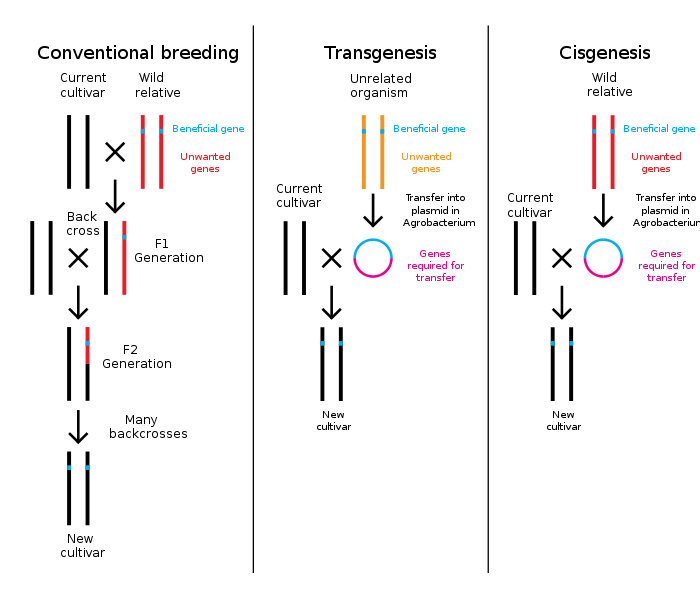
Cisgenesis
Encyclopedia

Cisgenesis (from "same" and "beginning") is one term for organisms, which have been engineered using a process by which genes are artificially transferred between organisms that could otherwise be conventionally bred. Unlike in transgenesis
Transgenesis
thumb|300px|right|A diagram comparing the genetic changes achieved through conventional plant breeding, transgenesis and cisgenesisTransgenesis is the process of introducing an exogenous gene – called a transgene – into a living organism so that the organism will exhibit a new property and transmit...
, genes
Gênes
Gênes is the name of a département of the First French Empire in present Italy, named after the city of Genoa. It was formed in 1805, when Napoleon Bonaparte occupied the Republic of Genoa. Its capital was Genoa, and it was divided in the arrondissements of Genoa, Bobbio, Novi Ligure, Tortona and...
are only transferred between closely related organisms. The term was first used in a PhD thesis by Jan Schaart of Wageningen University
Wageningen University
Wageningen University and Research Centre is a Dutch public university in Wageningen, The Netherlands. It consists of Wageningen University, the Van Hall-Larenstein School of Higher Professional Education, and the former agricultural research institutes of the Dutch Ministry of Agriculture...
in 2004, discussing making strawberries
Strawberry
Fragaria is a genus of flowering plants in the rose family, Rosaceae, commonly known as strawberries for their edible fruits. Although it is commonly thought that strawberries get their name from straw being used as a mulch in cultivating the plants, the etymology of the word is uncertain. There...
less susceptible to Botrytis cinerea
Botrytis cinerea
Botrytis cinerea is a necrotrophic fungus that affects many plant species, although its most notable hosts may be wine grapes. In viticulture, it is commonly known as botrytis bunch rot; in horticulture, it is usually called grey mould or gray mold.The fungus gives rise to two different kinds of...
.
In Europe
Europe
Europe is, by convention, one of the world's seven continents. Comprising the westernmost peninsula of Eurasia, Europe is generally 'divided' from Asia to its east by the watershed divides of the Ural and Caucasus Mountains, the Ural River, the Caspian and Black Seas, and the waterways connecting...
currently this process is governed by the same laws as transgenesis but researchers at Wageningen University in the Netherlands
Netherlands
The Netherlands is a constituent country of the Kingdom of the Netherlands, located mainly in North-West Europe and with several islands in the Caribbean. Mainland Netherlands borders the North Sea to the north and west, Belgium to the south, and Germany to the east, and shares maritime borders...
feel that this should be changed and regulated in the same way as conventionally bred plants. However, other scientists, writing in Nature Biotechnology
Nature Biotechnology
Nature Biotechnology is an academic journal covering the science and business of biotechnology.Nature Biotechnology is a continuation of Bio/Technology , which was founded in 1983 and renamed in 1996. It is published monthly by the Nature Publishing Group, a division of Macmillan Publishers Ltd...
have disagreed writing, "Although lowering regulatory hurdles may increase profits in the short term, it could place the long-term potential of improved agriculture through GE in jeopardy. We would prefer to see plant molecular biologists focus their attention on developing more sophisticated methodologies such as a targeted gene knock-in strategy or genomics-assisted breeding rather than on schemes to evade regulatory mechanisms with products that are still generated by relatively crude transgenic technology."
Cisgenesis and transgenesis use artificial gene transfer, which results in far less change to an organism's genes compared to mutagenesis
Mutagenesis
Mutagenesis is a process by which the genetic information of an organism is changed in a stable manner, resulting in a mutation. It may occur spontaneously in nature, or as a result of exposure to mutagens. It can also be achieved experimentally using laboratory procedures...
which was widely used before genetic engineering was developed.
Some people believe that cisgenesis should not face as much regulatory oversight as genetic modification through transgenesis. Cisgenesis differs from conventional breeding because it can potentially create new varieties of crops more quickly and cheaply and only selected beneficial genes are transferred and not other genes nearby on the chromosome
Chromosome
A chromosome is an organized structure of DNA and protein found in cells. It is a single piece of coiled DNA containing many genes, regulatory elements and other nucleotide sequences. Chromosomes also contain DNA-bound proteins, which serve to package the DNA and control its functions.Chromosomes...
. In conventional breeding multiple backcrosses
Backcrossing
Backcrossing is a crossing of a hybrid with one of its parents or an individual genetically similar to its parent, in order to achieve offspring with a genetic identity which is closer to that of the parent...
must be performed, each taking at least several months, to create a new cultivar
Cultivar
A cultivar'Cultivar has two meanings as explained under Formal definition. When used in reference to a taxon, the word does not apply to an individual plant but to all those plants sharing the unique characteristics that define the cultivar. is a plant or group of plants selected for desirable...
. Cisgenesis can achieve the same results in a fraction of the time. One application of cisgenesis is to create blight resistant potato plants by taking resistance from wild varieties and transferring them into high yielding varieties.
Related classification scheme
A related classification scheme proposed by Kaare Nielsen is:| Source of genetic modification | Genetic variability via conventional breeding | Genetic distance | |
|---|---|---|---|
| Intragenic | Within genome | Possible | Low |
| Famigenic | Species in the same family | Possible | |
| Linegenic | Species in the same lineage | Impossible | |
| Transgenic | Unrelated species | Impossible | |
| Xenogenic | Laboratory-designed genes | Impossible | High |
Diagram


